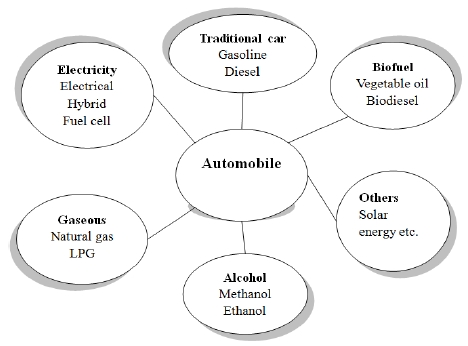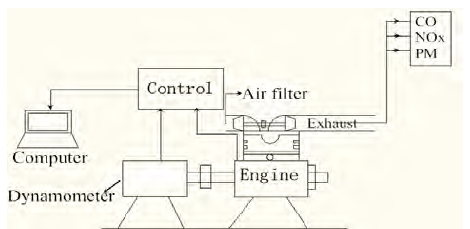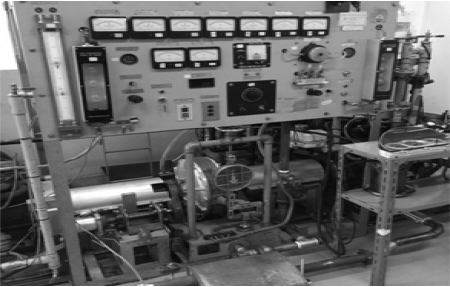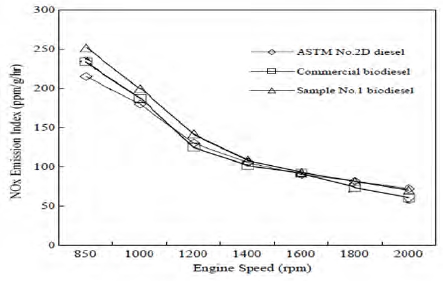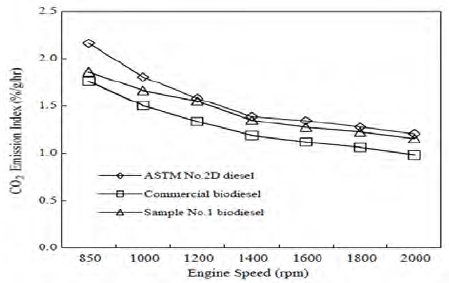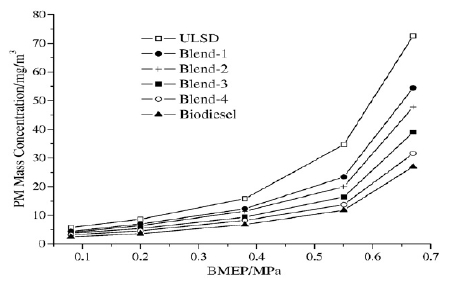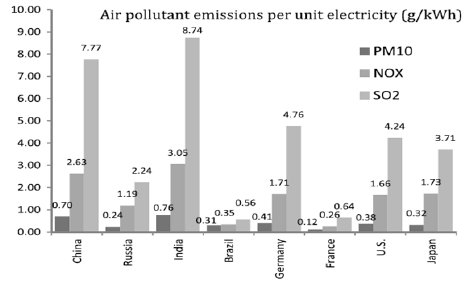
Research on the method to reduce exhaust gas of internal combustion engine
Copyright ⓒ The Korean Society of Marine Engineering
This is an Open Access article distributed under the terms of the Creative Commons Attribution Non-Commercial License (http://creativecommons.org/licenses/by-nc/3.0), which permits unrestricted non-commercial use, distribution, and reproduction in any medium, provided the original work is properly cited.
Abstract
With the development of the society and the improvement living standard, more and more people realized that environment is very important to the descendants. Tens of thousands of cars increasing every year caused a heavy burden on the environment. The automobile emissions includes not only CO2 but also many other harmful gas. Nitric oxide (NO2) in the NOx compound has a strong ability to absorb infrared rays. Compared with the same concentration of carbon dioxide, NO2 is about 250 times the threat of global warming than CO2.Carbon monoxide (CO) is colorless, odorless, tasteless gas, but inhalation has a lot of damage to the human body. It will combine the blood of the red protein so that it cannot provide oxygen to the body tissue, leading to the occurrence of suffocation. Biodiesel is considered to be a promising alternative to reducing the pollution of diesel engines, boilers and other combustion equipment. Biodiesel can be extracted from plants such as soybeans, rape, palm, etc., and can also be extracted from animal fats and oils. Biodiesel can also be produced by chemical processes such as transesterification of waste oil. Fossil energy is drying up. There are some different kinds of cars for promotion during these years like biofuel vehicle, electric vehicle (EV) and so on. This paper will focus on that how to reduce theCO2, CO, NOx and particle matter emission from conventional cars. Through the comparison of different types of automobile emissions, we will know what kind of car is more suitable for in the future development. We can never stop our way to protect the environment.
Keywords:
Automobile emissions, Conventional cars, Biofuel vehicle, Electric vehicle1. Introduction
As the energy pressure increasing, countries while looking for new green energy and using the biodiesel as a kind of alternative energy sources in these years. One of the reasons is that there are a lot of methods to obtain biodiesel, for example vegetable oil, animal fat and waste cooking oil et al. The other reasons that why biodiesel can be alternative energy is in followings. First of all is that the biodiesel can be mixed with pure diesel directly in various proportions. In addition is that it also can run on without any modification on the engine. And it can also decrease some harmful emissions in a sense.
According to the International Organization of Motor Vehicle Manufacturers (OICA), today, more than 1 billion motorized vehicles are driven on the road worldwide [1]. The annual exhaust emissions from the vehicles bring tremendous pressure to the natural environment. And it is expected that this number would reach 2 billion in the next decades [2]. The emergence of the El Niño phenomenon, the rise of the PM2.5 index and the acid rain are all related to the burning of fossil fuels. Fossil fuel after burning emissions has long attracted the attention of researchers, some new energy vehicles have come into being one after another, like hybrid electrical vehicle, electrical vehicle and so on. In Figure 1 we can see what kind of car classification is now available.
There are many investigations were done about the influence of the biodiesel on the combustion, performance evaluation and emissions characteristics of diesel engine. First introduce the hybrid car is also equipped with two kinds of power source - the thermal power source (produced by the traditional gasoline engine or diesel engine) and electric power source (battery and motor) of the car. By using the motor on a hybrid vehicle, the power system can be flexibly regulated in accordance with the actual operating conditions of the vehicle, while the engine is kept in the best overall performance area, thereby reducing fuel consumption and emissions [3].
As the electric car has not yet been massively promoted, it is better to look for an alternative energy vehicle to improve the immediate tense energy situation. Although bio-fuel vehicles will also emit greenhouse gases, because it is renewable energy, in the electric car without a wide range of promotion process, the development of bio-fuel vehicles is definitely the best direction of the overdue period. We will focus on traditional cars and bio-fuel vehicles in this review.
Biofuels vehicles, also known as ecological fuels, refers to the composition of organic matter or made of fuel, such as corn made of ethanol fuel, or the recovery of edible oil made of biodiesel. Biodiesel can be extracted from plants such as soybeans, rape, palm, etc., and can also be extracted from animal fats and oils. Biodiesel can also be produced by chemical processes such as transesterification of waste oil. It is different from traditional fuels such as oil and is fuel that can be regenerated [4]. The US Environmental Protection Agency (USEPA) and the US Food and Drug Administration (FDA) have considered biodiesel as a clean alternative fuel or fuel additive [5]. The work to be done in this paper is to compare the emissions from the combustion of different biofuels with the components of the gasoline and diesel vehicle exhaust to obtain which fuel has little effect on the environment.
2. Experimental Setup and Procedure
The Figure 2 shows the schematic diagram of the experiment and the experimental set-up in the Figure 3. The experiments were conducted with a four-cylinder, turbocharged diesel engine, the character of this engine is shown in Table1. The engine output power was measured with an eddy current dynamometer. The engine is experimented with a torque of 10 kgf and a variable speed engine from 850 to 2000 rpm to simulate the medium running load conditions of the engine. Each experiment was repeated three to five times to obtain the mean of the experimental data. The engine exhaust gas temperature is monitored by the thermocouple sensor to assess the stability of the engine under different loads. The in-cylinder gas pressure was recorded with A. Kistler Piezo Star pressure Sensor. The engine exhaust from the exhaust manifold is diluted by the Dekati diluent [5].
The main purpose for dilution was to bring down the concentration of exhaust gases and particles within the measuring range of the different measuring instruments. NO and CO2 concentrations in the raw exhaust were measured by CAI model 600 series gas meters. Another CO2 meter (SABLE CA-10) was used to measure the CO2 concentration from the diluted exhaust. Use dilution of carbon dioxide and raw carbon dioxide to calculate the dilution factor.
Biofuels produced from renewable sources (eg. organic wastes derived from plants or biomass) can supplement the use of petrochemical fossil fuels to reduce the adverse effects of traditional fuels on the environment [8]. The bench mark comparison is the ASTM No. 2D diesel in the comparison test, we also got two other samples of commercial biodiesel and soybean oil. The characteristics of these three oils are shown in the table below .The Table 2 is The fuel properties of the ASTM No. 2Ddiesel fuel, the Table 3 shows the fuel properties of commercial biodiesel and the Table 4 introduces the properties of biofuels from soybean [5]. Each experiment is repeated three to five times to ensure that the accuracy of the average of the experimental data is calculated.
3. Emissions Comparison
In this part engine out exhaust emissions are discussed. We will not only compare the emissions of biofuel diesel and ordinary diesel, we will also add electric vehicles to the comparative ranking [9]. Compared with ordinary diesel biodiesel has the following advantages: high oxygen content, good biodegradability and better lubrication performance, in addition to a good engine with low temperature start performance. Biodiesel also has the advantage that it is not necessary to improve the engine can be used, which is the promotion of biodiesel use are beneficial.
Figure 4 shows the emissions of carbon monoxide (CO) when the engine is burned at three different fuels at different speeds and at constant engine torque. The CO emission index is defined by (ppm) divided by the corresponding fuel consumption rate (g / h) [10]. We found that CO emissions decreased as the engine speed increased. This is mainly due to the relatively low temperature of the engine cylinder in the case of a lower engine speed, which will effectively convert the CO component to CO2. In addition, we found that the CO concentrations produced by these three biodiesel were significantly reduced after comparison with ASTM No. 2 diesel. This biodiesel contains about 10% oxygen on a mass basis and has lower carbon content than ASTM No. 2 diesel.
In the same experimental case, the oxide (NOx) emission index is shown in Figure 5. The NOx emission index is defined byNOx emissions (ppm) divided by the corresponding fuel consumption rate [12].
From the figure we can see that NOx emissions decrease as the engine speed increases. This is mainly due to the increased volumetric efficiency and gas flow motion in the engine cylinder at higher engine speeds due to faster mixing between fuel and air and shorter ignition delays. In addition, we can see that the addition of biodiesel engine in the course of the process of NOx emissions will rise. From this we can also see that by adding biodiesel way to reduce the role of nitrogen oxides emissions is not obvious. For the reduction of nitrogen oxides emissions, but also need to find other ways to achieve.
For greenhouse gases, carbon dioxide is undoubtedly the most. For carbon dioxide itself, if the amount of carbon dioxide is equal to the amount of carbon dioxide required for photosynthesis of surface plants, then carbon dioxide is not a harmful gas. Petroleum fuel emissions have harmful effects on the nature. For example, uncontrolled carbon dioxide emissions can lead to excessive greenhouse gases, which can lead to higher temperatures (global warming) and lower temperatures (global cooling).The other major harmful emissions are CO, NOx and UHC. In addition, our energy reserves are decreasing proportionally to increasing energy demand. Therefore, in the past few decades, for the alternative fuel research has been very seriously, in this sense on this topic a lot of research. So in this article we also talked about CO.
The carbon dioxide (CO2) emission index which uses sample ASTM No. 2D diesel and commercial biodiesel as the engine test fuel, is shown in Figure 6, where the engine torque is constant and the engine speed is constant [11]. The carbon dioxide emission index decreases as the rotational speed of the four fuel engines increases. Three kinds of biodiesel emissions of carbon dioxide than diesel emissions are low. This phenomenon is due to the increase in the oxygen content of biodiesel resulting in low-carbon fuels in biodiesel and has a lower proportion of carbon and hydrogen than diesel fuels. As a result, biodiesel and air combustion will produce lower CO2 emissions than ASTM No. 2D diesel.
Moreover, the combustion of the sample 2 biodiesel produced the lowest CO2 emission index among the three fuels, as shown in Figure 6. This may be due to the fact that the biodiesel has the lowest equivalent ratio and the CO2 emission concentration decreases as the equivalence ratio decreases in the range of less than 1.In addition, in the work shown in Figure 4 ~ Figure 6, ASTM II diesel, sample 1 biodiesel, commercial biodiesel these three kinds of fuel carbon dioxide emissions and carbon content of the same. ASTM No. 2D diesel with the highest carbon content is also verified in Figure 6 with the largest carbon dioxide emission index.
People are increasingly concerned about the haze, it can be said that the exhaust gas in the car is also one of the reasons for the formation of haze, which is why in recent years, particulate emissions into the car exhaust emissions management. The results of most previous researchers have focused on the effects of the addition of biodiesel on the particulate matter emissions of the original diesel internal combustion engine, and this time we added the particle size to the study.
For the study of particulate matter exhaust, we also use the author of Yage et al. [17] In the course of their test process is not described in detail, focusing on the analysis of particulate matter emissions. Figure 7 show the effects of biodiesel and engine load on particulate mass concentration and effect of biodiesel and engine load on particulate number concentration and size distribution. From the figure we see that in the pure diesel oil after adding biodiesel, regardless of the level of engine load, particulate matter emissions are reduced. In addition to this can also be seen in the complete burning of biodiesel, the particulate matter emissions is the least. The particulate reduction is associated with the reduction of soot and sulfate in the particulate. The blended fuel has an increase in fuel oxygen but a decrease of fuel carbon, leading to a reduction of soot formed. But we can find that biodiesel added the small diameter of the particulate matter has increased. This is not a good thing.
We all know that health effects are greater for smaller particles. The pollutant emission coefficients are different for each of the various electrical power sources. For example, the CO2 emission from generating one unit of energy via nuclear or renewable energy is far less than that generated using thermal power [13]. In different power production, the use of coal in the process of carbon dioxide emissions the largest, followed by oil power generation, and then natural gas. In addition to carbon dioxide, we also need PM10, NOx, SO2 and other major pollutants to study. The emission factors for pollutant emissions in the upper and lower phases of power production are given in Figure 8. These pollutants all have large effects on the health of residents and the environment. As shown in Figure 8, we can see the pollutant emission coefficients for electrical power generation in India are the largest due to its high proportion of thermal power use and poor LLR. As thermal power usage in France is the lowest among the eight countries (8.57%), France presents the lowest emission coefficients [14]. Therefore, the conclusion is that the use of electric vehicles is not the more environmentally friendly, the number of emissions is related to the source of power [15].
4. Conclusions
In this paper, we study how to reduce the exhaust emissions of internal combustion engines. We have also cited CO, NOx, CO2, PM four emissions in the laboratory experiment to get the conclusion, and we also for the electric vehicle primary energy consumption problems were discussed. And finally get the following conclusions:
(1) Through the study we can see that the addition of biodiesel in conventional diesel fuel can reduce CO and CO2 in the exhaust emissions of internal combustion engines, mainly due to the fact that biodiesel increases the oxygen content in the fuel.
(2) Particulate emissions on the human heart and lung function is relatively large, through the study we also get the use of biodiesel can also be achieved in the exhaust gas emissions of internal combustion engine reduction. The particulate reduction is associated with the reduction of soot and sulfate in the particulate.
(3) For the emission of NOx, we can see that biodiesel has no significant effect on reducing NOx from the results of the study. To some extent, the addition of biodiesel leads to an increase in NOx emissions. This result is due to an increase in the oxygen content of biodiesel resulting in an increase in the postcombustion cylinder temperature.
(4) Due to the majority of the energy to the electric car or after the fire power supply, for most developing countries and cannot do the emission of electric vehicles than bio-fuel vehicles emissions are lower. Electric vehicles are not the more environmentally friendly, the number of emissions is related to the source of power.
(5) From the experiment, we can easily see that biodiesel is very obvious for reducing the emission of particulate matter, which also gives us how to reduce particulate emissions.Reduced particulate matter emissions and full combustion are good to prevent nozzle clogging, which shows that biodiesel can also be safe to run the engine.
(6) To reduce the emissions of automobile exhaust, is to continue to seek new renewable energy to use and reduce the fossil energy combustion It is necessary to develop a renewable energy source for biofuels at a stage that cannot change the energy structure of most countries.
Acknowledgments
This research was supported by The Leading Human Resource Training Program of Regional Neo industry through the National Research Foundation of Korea(NRF) funded by the Ministry of Science, ICT and future Planning(NRF-2016H1D5A1909917)
References
- International Organization of Motor Vehicle Manufacturers (OICA), http://www.oica.net/wp-content/uploads//totalinuse-2014.pdf Accessed December 11, 2012.
- D. Sperling, and D. Gordon, “Two Billion Cars Transforming a Culture”, TRNews, lxxiii, 259, p3-9, 11 (2008).
-
K. S. Gallagher, and E. Muehlegger, “Giving green to get green Incentives and consumer adoption of hybrid vehicle technology”, Journal of Environmental Economics and Management, 61(1), p1-15, (2011).
[https://doi.org/10.1016/j.jeem.2010.05.004]

-
B. P. Y. Loo, and L. Li, “Carbon dioxide emissions from passenger transport in China since 1949: Implications for developing sustainable transport”, Energy Policy, 50, p464-476, (2012).
[https://doi.org/10.1016/j.enpol.2012.07.044]

-
C. Y. Lin, and H. A. Lin, “Diesel engine performance and emission characteristics of biodiesel produced by the peroxidation process”, Fuel, 85(3), p298-305, (2006).
[https://doi.org/10.1016/j.fuel.2005.05.018]

-
L. Li, and B. P. Y. Loo, “Alternative and Transitional Energy Sources for Urban Transportation”, Current Sustainable/Renewable Energy Reports, 1(1), p19-26, (2014).
[https://doi.org/10.1007/s40518-014-0005-6]

-
M. N. Nabi, M. M. Rahman, M. A. Islam, F. M. Hossain, P. Brooks, W. N. Rowlands, J. Tulloch, Z. D. Ristovski, and R. J. Brown, “Fuel characterisation, engine performance, combustion and exhaust emissions with a new renewable Licella biofuel”, Energy Conversion and Management, 96, p588-598, (2015).
[https://doi.org/10.1016/j.enconman.2015.02.085]

-
M. A. Fazal, A. S. M. A. Haseeb, and H. H. Masjuki, “Biodiesel feasibility study: An evaluation of material compatibility; performance; emission and engine durability”, Renewable and Sustainable Energy Reviews, 15(2), p1314-1424, (2011).
[https://doi.org/10.1016/j.rser.2010.10.004]

-
N. Tanikawa, T. Imai, and K. Urano, “Characteristics of continuous analyzers for nitrous oxide in flue gas from municipal incinerators”, Science of the Total Environment, 175(3), p189-198, (1995).
[https://doi.org/10.1016/0048-9697(95)04845-6]

-
S. C. Fry, “Oxidative scission of plant cell wall polysaccharides by ascorbate-induced hydroxyl radicals”, Biochemical Journal, 332(2), p507-515, (1998).
[https://doi.org/10.1042/bj3320507]

- J. B. Heywood, Internal Combustion Engine Fundamentals, McGraw-Hill, (1988).
-
M. Lapuerta, O. Armas, and J. Rodríguez-Fernández, “Effect of biodiesel fuels on diesel engine emissions”, Progress in Energy and Combustion Science, 34(2), p198-223, (2008).
[https://doi.org/10.1016/j.pecs.2007.07.001]

-
Foley, B. Tyther, P. Calnan, et al. , “Impacts of Electric Vehicle charging under electricity market operations”, Applied Energy, 101, p93-102, (2013).
[https://doi.org/10.1016/j.apenergy.2012.06.052]

-
Y. Wu, and L. Zhang, “Can the development of electric vehicles reduce the emission of air pollutants and greenhouse gases in developing countries?”, Transportation Research Part D: Transport and Environment, 51, p129-145, (2017).
[https://doi.org/10.1016/j.trd.2016.12.007]

- P. Soltic, C. Bach, C. Lämmle, and B. Ó Gallachóir, “Clean engine vehicle - A natural gas driven Euro-4/SULEV with 30 % reduced CO2-emissions”, SAE Technical Paper Series, 01-0645, p8-18, (2004).
-
Y. Di, C. S. Cheung, and Z. Huang, “Experimental investigation on regulated and unregulated emissions of a diesel engine fueled with ultra-low sulfur diesel fuel blended with biodiesel from waste cooking oil”, Science of The Total Environment, 407(2), p835-846, (2009).
[https://doi.org/10.1016/j.scitotenv.2008.09.023]

- World Bank, http://data.worldbank.org/ World Bank Database Available at: 2016, Accessed December 20, 2016.

